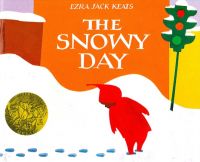The Snowy Day (1962)
The Snowy Day is an award-winning book that first published in 1962, written by American author and illustrator Ezra Jack Keats. The book tells a story about Peter, a boy, who explores his neighborhood and experiences snowy days. Although this is never mentioned in the text, Peter is African-American. The Snowy Day becomes the first picture book with an African-American protagonist to win a major children’s award after received the 1963 Caldecott Medal for this collage artwork. This book considered a reminder the importance of diversity in children’s literature.
Contents
Plot
The story is set in a city during winter where a boy starts his day discovering that the snow has fallen overnight. In his red snow suit, he goes out to find that the snow is piled high, then begin to make a footprint and a trails through the snow. He encounters older kids playing a snowball fight, but he soon realized that his four years old self is too young to play with bigger kids after he got knocked down by a stray of snowball. So, he makes a snowman, snow angles and slides down the hill. Before Peter makes his way back to home, he stashed a snowball in his pocket, but then got sad after finding out that his snowball has melted before he goes to bed. He also dreams that the sun has melted all the snow that night. The next morning, he wakes up to a lot of snow and goes out again with a friend to have more fun in the snow. [1]
Inspiration
Character Peter is inspired from a short photo essay focused on a little boy in Liberty County, Ga., who was about to undergo a blood test published by Life magazine in 1940. Keats was mesmerized by the boy in the photo and clipped a group of photographs out of the magazine. Being raised as a child of immigrant Polish parents and lived in a predominantly Jewish area of East New York, Keats could empathized with children of different backgrounds and races, and he was able to find a similarity with those who experiencing hardship and racism that at times played out in his own personal experiences.[2]
Controversy
Despite being recognized for his work with Caldecott Medal for the most distinguished picture book in 1963, Keats was criticized for tokenism, because while he was telling a story of a black child, he was white. By the time the book was published, America was rife with racial struggle and it was during the peak of the Civil Rights movement. There are a lot of civil rights leaders who worried about Keats’ approach on describing Peter’s character because at that time, when white authors written about black character, it had not gone well.
He was also criticized for not addressing Peter’s race in the text, for being too integrationist and for not truly representing or celebrating African-American culture or racial identity. But, to answer those critics, Keats held his view by saying it wasn’t important and it wasn’t the point. The point is that this is a beautiful book about a child’s encounter with snow and the wonder of it.[3]
Impact
Because of this book, Keats received a lot of letters from children with their own versions of his deceptively simple collage illustrations. Even children came from non-snowy places could relate to Peter’s adventure. There’s one of the most memorable letter from teacher whose students had read The Snowy Day.
“The kids in my class, for the first time, are using brown crayons to draw themselves,” she says. "These are African-American children. Before this, they drew themselves with pink crayons. But now, they can see themselves."[4] That is why diversity in children’s book is very important. It helps them to see themselves reflected in the books they read and give them sense of belonging.
References
- ↑ Keats, Ezra Jack. The Snowy Day. The Viking Press, 1962.
- ↑ Crawton, Melissa. Ezra Jack Keats’ The Snowy Day. Retrieved on December 13, 2020.
- ↑ Warnes, Tim (2012). Why We Need More Books Like The Snowy Day. Retrived on December 13, 2020.
- ↑ NPR (2012). The Snowy Day Breaking Color Barriers Quietly. Retrieved on December 13, 2020.

